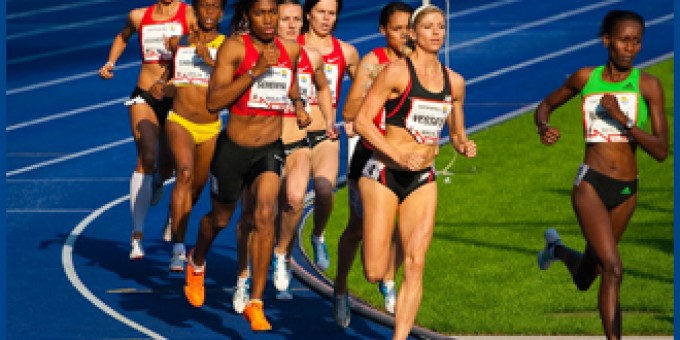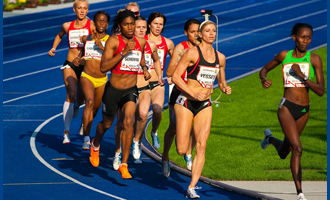
The 2012 Summer Olympic Games in London is the first in which female athletes have been represented in all events and the first in which female athletes from Saudi Arabia have participated. Despite these improvements, the Olympics represent a paradox that produces two different outcomes with respect to women’s sport: on the one hand, female athletes and women’s sport, especially here in the United States, receive more (and more respectful) media coverage during Olympic years. As New York Times journalist Frank Bruni wrote, the Olympics are where “girl power gets its sweaty, sinewy due.” Indeed, in these weeks, women experience a degree of parity with their male counterparts, serving as proud representatives of the nation-state. However, in some ways, it’s this sense of nationalism that has contributed to the establishment of sex testing policies in women’s sports. By raising the visibility of female athletes and women’s sport, national pride and athletic equity in the Olympics have increased surveillance of female athletes, who have found themselves subject to sex testing for eligibility. It’s all well and good for women to gain the spotlight, the argument seemed to go, but they must be protected from their international rivals who might hold a hidden advantage: they might be technically (in any number of difficult-to-spot ways) male.
Thus, the significance of South African star Caster Semenya, running for Olympic gold in the 800 meter finals in London.

In post-apartheid South Africa, sport has played a significant role in nation-building and in helping to stabilize the country during a time of transitional democracy. Black women helped bring together various national identities both within sport and in the wider society in South Africa. As both a black woman and an athlete on the international stage, then, Caster Semenya has been an important national icon—she was even the first black South African woman to win a gold medal at an IAAF World Championship. Given her upbringing in an impoverished rural town with high unemployment and her international success in sport, Semenya served in many ways as a powerful embodiment of the ascendency of the “new” South Africa. Thus, when she was accused of not being a “real” woman at the 2009 IAAF World Championship, it caused such a controversy even South Africa’s president spoke out on her behalf, asserting and solidifying both her gender identity and her position as a representative of the nation-state. Fans, politicians, and South Africans of all stripes claimed Semenya as their “Golden Girl,” “Our First Lady of Sport.”
As intriguing as her story is on its own terms, Semenya’s is just the most recent and most famous chapter of a much larger, longer running controversy surrounding sex testing in international Olympic sport.
Looking Back
In the early 20th century, women’s participation in sport competitions dramatically increased, as did the quality of their performances. During the Cold War, countries used sport to justify and legitimate the economic, political, and social organization of capitalist and communist societies, and women’s sport participation found itself at the center of an ideological war. Images of feminine athletes from the United States were juxtaposed with those of their “manly” competitors from the Soviet Bloc. For the first time, questions were raised regarding the sex of the participants in women’s competitions. Capitalist countries suspected Communist countries of not fielding “real” women (an assertion based solely on appearance). Many feared the elite performances being seen in women’s sport were not the accomplishments of “real” female competitors—a violation of the purity, fairness, and sanctity of sport. These concerns and the high political stakes of international competition at the time eventually led to the implementation of mandatory sex testing policies. Now, in the post-Cold war era, tensions between communism and capitalism have been replaced by tensions between Global North and Global South nations. Some have suggested that, rather than Soviets, it’s the women of the Global South who will now become subject to gender accusations.The International Olympic Committee implemented mandatory sex testing in 1968, and the policy continued until the 2000 Olympic Games. The first sex tests (performed prior to mandatory testing) involved an often humiliating physical and visual inspection of the genitals. Advances in technology, specifically the Barr body (chromosome) test and later the polymerase chain reaction (PCR) test of the SRY gene, eliminated reliance on just a visual inspection, but biomedical experts have noted the weakness of these tests to identify or determine sex/gender. At a basic level, the tests are known for false positives. For example, in the 1996 Summer Olympics in Atlanta, eight of over 3,000 female athletes tested “positive” (that is, suspect, gender-wise) using the PCR test. Yet, all eight athletes were allowed to compete, as further medical testing determined that the athletes did not hold an “unfair advantage.” Over time, biomedical scientists came to believe sex testing of any type was insufficient for determining “real” sex, because sex itself is comprised of multiple components including genes, chromosomes, hormones, and genitalia.
So, while the mandatory policy was still in place, experts in the field advised the International Olympic Committee and other sport organizations against the use of such tests. Medical professionals and scientists asserted sex testing in sport constituted an invasion of privacy, harassment, and discrimination “based on arbitrary assumptions of advantage.”
Despite ongoing concerns of medical professionals, the prevalence of false positives and the use of tests that do not conclusively determine sex, and the challenge of developing a sound procedure to determine an athlete’s sex (assuming that’s possible or desirable), the IOC and other sport governing bodies continue with policies that allow for the testing of athletes or the monitoring of participants in women’s competitions. One aspect of the policy that has changed is that sex tests are no longer mandatory for female athletes (as of the 2000 Games). Another change is that the IOC no longer claims to test or verify the sex of the athlete. Instead, according to the most recent IOC policy, the concern resides in the androgen levels of female athletes.It should be noted here that athletes in male events have never had to undergo any gender verification or sex test. The IOC assumes that no woman could possibly outperform a man, so there’s no concern a female athlete might masquerade as (and compete at an Olympic level) as a male. Indeed, the IOC’s “Regulations on Female Hyperandrogenism,” released in June 2012, states that the “performances of male and female athletes may differ mainly due to the fact that men produce significantly more androgenic hormones than women and, therefore, are under stronger influence of such hormones.” Hence, the immediate astonishment and outcry when 16-year-old female Chinese swimmer Ye Shiwen clocked a lap time faster than that of US champion Ryan Lochte in Olympic competition last week. However, since only athletes entering women’s competitive events are tested or monitored, it seems the policies rest on an assumption of natural, categorical male superiority.
Rationalizing Inequity
Given the apparent belief in the natural physical superiority of male athletes, a main rationale used by sports organizational bodies regarding the need for sex testing or monitoring of female athletes is the need to ensure a level playing field by policing any “unfair advantages” athletes in women’s competitions may have. Historically, the rationale was more explicit: it was meant to prevent men from disguising themselves as women and, well, beating them. But where there’s a policy, usually there’s a precedent.

The most frequently—and only—cited case of such sporting shenanigans occurred in the 1936 Berlin Olympics. Hermann (Dora) Ratjen, a man, was forced by German officials to compete in the women’s high jump event disguised as a woman. Despite his “advantage,” Ratjen placed only 4th—all three medal winners were female. There are no other documented cases in which sex testing revealed a male athlete knowingly masquerading as a woman. Since, with more intricate testing, there have been several high profile examples of female athletes who “failed” a sex test and were determined to not be “real” females. Often they experienced no competitive advantage, yet medals were revoked and the athletes were banned from competition.
In another odd aspect of modern sex-testing, the IOC has enacted its sex-determination policies to determine the sex of athletes (including the 2012 policy which purports to determine the appropriate hormone levels that are fair in women’s competition), but seems to tolerate a myriad of other advantages that could be deemed unfair. For example, several basketball players have a condition called acromegaly, which is responsible for excessive tallness. Likewise, a number of female volleyball players have been found to have Marfan’s Syndrome, a disorder that contributes to unusual height. For his part, endurance skier Eero Mantyranta has an inherited genetic mutation, which causes high hemoglobin and increased oxygen capacity—a clear advantage in his sport.
And while the IOC is concerned with the androgen levels of female athletes, the same concern does not extend men. Other than testing for exogenous levels of testosterone (which would indicate doping or steroid use), the IOC and other international governing bodies are not concerned with the endogenic testosterone levels of male athletes. The IOC’s 2012 policy claims, “androgenic hormones have performance-enhancing effects, particularly on strength, power and speed, which may provide a competitive advantage in sports” (a contested claim as sport performance is the result of an endless intersection of factors that include not only physiology but also training, diet, facilities, equipment, and so on). So, if we accept the IOC’s logic, it is curious why the governing body might not be concerned that at least some males are “too male” to compete.
How Inequity Breeds Inequity
Sport has played an important cultural role regarding the ostensible “proof” of the “naturalness” of gender difference. Indeed, cultural assumptions about the differences between men and women are so much a part of athletic competition at all levels that we almost never even recognize them at all. But it is male dominance more than gender difference that is also most often at stake in sport.
The belief in the categorical superiority of men actually helped shape the development of sport in the United States in the 1800s. One way that men as a group responded to the rapid changes in gender roles during this time was with a degree of anxiety and confusion about what it meant to be a man, given the increasing similarity of tasks allotted to women and men. Sport historians note that the formation of sport (and other male-only institutions such as the Boy Scouts and the YMCA) helped assuage fears of the perceived feminization of boys and men. These institutions provided a suitable context in which to “turn boys into men.” In turn, girls and women were mostly denied access, due to fears that sport would “masculinize” them and, of course, because they were “physically inferior” anyway. It is worth recalling that there was no women’s Olympic marathon until 1984; until then, medical experts deemed that women were vulnerable to reproductive problems if they were to complete a 26.2-mile course.
This sort of history explains why women’s entrance into the coveted fields of male-dominated sport has been so contested. Even as women’s participation has increased at all competitive levels, it continues to challenge what our society believes women are capable of, as well as their appropriate societal roles. It also reaffirms cultural beliefs about the “natural,” physical inferiority of women. Because of this, sport sociologist Michael Messner has called female athletes “contested terrain,” and other scholars have drawn attention to the ways in which female athletes must negotiate a complex array of societal expectations of femininity within sport’s values, norms, and behaviors (all of which have historically been associated with masculinity).Because sport has been, in the past and still today, lauded as a way to make boys into men, when women participate—especially when they excel—there is a secondary problem. They are hyper-sexualized and hyper-feminized (as images of female athletes in Sports Illustrated’s swimsuit issue would attest), accused of being lesbians, or presumed to really be men (for example, Caster Semenya and the American collegiate basketball star Brittney Griner). Checking to verify that female athletes are in fact “real” women, while assuming that all male athletes in sport are “real” men, comes out of and reinforces the belief that “real” women cannot possibly be outstanding athletes. A belief that gender disparities have merit upholds, among other inequities in sport, sex testing policies.
Leveling the Field
Elsewhere we have argued that if sport’s governing bodies insist on monitoring athletes’ gender, the policy should be applied equally and consistently. Male athletes with levels of testosterone or androgens that exceed the “normal male range” should also be prevented from participating as male athletes in men’s competitions. Given the IOC’s logic, this would ensure a level playing field in men’s events. Interestingly, though, the IOC has not released a policy regarding what constitutes a “normal” range of male testosterone. But of course, this argument is a rhetorical device: testosterone is only an advantage to the extent that the body and muscles can respond to it. For example, female athletes with Androgen Insensitivity Disorder (a condition that would have resulted in a “failed” sex test under prior sex testing policies) are actually at a disadvantage because their bodies cannot respond to circulating androgens. In other words, androgen or testosterone levels alone do not indicate an “unfair advantage” in sport any more than a height above 6’ is an “unfair advantage” for a volleyball or basketball player.

Further, sport scientists note that excellence in sport is a complex combination of biology, talent, diet, training, access to opportunity, equipment, facilities and a myriad of other factors that cannot be controlled or monitored. As a result, some have posed the important and frustrating question: “Can the IOC maintain a level playing field?” Considering biology alone, many athletes might be unable to compete; most, if not all, elite athletes are genetic outliers. As geneticist Eric Vilain observed, “If athletes were just average, sports would lack the allure and capital they currently enjoy.”
One way to address discriminatory sex-testing policies is to acknowledge how much sporting competition relies upon very traditional gender binaries and dualisms, distinctions that obligate men and women to compete separately (not to mention that impose a dualistic categorization scheme that may not always fully capture the complexity and variation among individual human beings). Another, perhaps even more important intervention is to realize that sport is not now and has never been a “level playing field.” This admission may prove beneficial, and not just for the athletes who are subject to sex, gender, and hormone monitoring policies. The myth of sport as a level playing field reproduces other forms of inequalities, including racism, economic inequality, able-ism, and others. Contemporary sport institutions and organizations are rife with inequalities that are accepted as part of the game (for example, better economic resources confer better access to training facilities, equipment, and coaches—all of which enhance sport performance).
Thus, rather than testing athletes to ensure no one has an “unfair advantage” in women’s competitions, we could accept that sport is never a level playing field, which would, in turn, eliminates any need to test athletes, male or female, in the first place.
Scientific experts acknowledge that the IOC and other sport governing bodies that implement sex testing are making a “reasoned choice among many imperfect options.” We believe that alone offers a compelling rationale to eliminate sex testing of female athletes.
Recommended Reading
Cheryl Cooky and Shari L. Dworkin (in press). “Policing the boundaries of sex: A critical examination of gender verification and the Caster Semenya controversy,” Journal of Sex Research.
Cheryl Cooky, Ranissa Dycus, and Shari L. Dworkin (2012). “‘What makes a woman a woman?’ vs. ‘Our First Lady of sport’: A comparative analysis of Caster Semenya in U.S. and South African news media,” Journal of Sport and Social Issues.
Shari L. Dworkin and Cheryl Cooky (2012). “Sport, sex segregation, and sex testing: Critical reflections on this unjust marriage,” American Journal of Bioethics 12(7):21-23.
Shari L. Dworkin, Amanda Lock Swarr, and Cheryl Cooky (in press). “Sport and sex and gender injustice: The case of South African track star Caster Semenya,” Feminist Studies.
Katrina Karkazis, Rebecca Jordan-Young, Georgiann Davis, and Silvia Camporesi (2012). “Out of bounds: A critique of the new policies on hyperandrogenism in elite female athletes,” American Journal of Bioethics 12:3-16.
Eric Vilain and Francisco J. Sanchez (2012). “Reproductive endocrinology: Athletes’ bodies, sexed bodies—intersexuality in athletics,” Nature Reviews Endocrinology 8:198-199.

Comments 3
Erin — September 21, 2012
If the goal of the IOC is fairness in sporting events, the IOC has a responsibility to ensure that this fairness occurs in both men's and women's sports. There are a variety of body types and abilities across both genders, and if certain females are being excluded for not fitting what is thought of as "typical", then males who are atypical should also be excluded. That being said, how does one define what a typical person is? Every body is different: every genetic makeup, every circulatory system, every digestive system, and every appearance. There is no true normal, and no person can control where they fall in the spectrum of people. Because of this, all athletes are forced to do their best with what they have, and though some people have certain differences that may give them advantages, would they really be punished for using their bodies to their fullest potentials?
Maleeka — December 2, 2012
Wonderful article, and greatly worded comment @Erin
Friday Roundup: Jan. 24, 2014 » The Editors' Desk — January 24, 2014
[…] “Woman Enough to Win?” Cheryl Cooky and Shari L. Dworkin on the history of gender and sex-testing in Olympic sport, just in time for Sochi! […]